West Midlands (region)
This article needs additional citations for verification. (March 2022) |
West Midlands | ||
|---|---|---|
Combined authorities West Midlands | | |
| Districts | ||
| Counties | ||
| Government | ||
| • Type | Leaders' board | |
| • Body | West Midlands Councils | |
| • House of Commons | 59 MPs (of 650) | |
| Area | ||
| • Total | 5,021 sq mi (13,004 km2) | |
| • Land | 5,019 sq mi (12,998 km2) | |
| • Water | 2 sq mi (5 km2) | |
| • Rank | 7th | |
| Population (2021)[2] | ||
| • Total | 5,954,240 | |
| • Rank | 5th | |
| • Density | 1,190/sq mi (458/km2) | |
| Ethnicity (2021) | ||
| • Ethnic groups | ||
| Religion (2021) | ||
| • Religion | List
| |
| GSS code | E12000005 | |
| ITL code | TLG | |
| GVA | 2021 estimate[4] | |
| • Total | £146.1 billion | |
| • Rank | 6th | |
| • Per capita | £24,530 | |
| • Rank | 6th | |
| GDP (nominal) | 2021 estimate[5] | |
| • Total | £164.6 billion | |
| • Rank | 6th | |
| • Per capita | £27,649 | |
| • Rank | 7th | |
| This article is part of a series within the Politics of the United Kingdom on the |
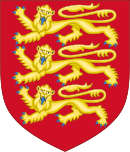 |
|---|
The West Midlands is one of nine official
The West Midlands region is geographically diverse, from the urban central areas of the
Geography
The official region contains the ceremonial counties of Herefordshire, Shropshire, Staffordshire, Warwickshire, West Midlands and Worcestershire.
There is some confusion in the use of the term "West Midlands", as the name is also used for the much smaller West Midlands county and conurbation which is in the central belt of the Midlands and on the eastern side of the West Midlands Region. It is also still used by various organisations within that area, such as West Midlands Police and West Midlands Fire Service.
The highest point in the region is Black Mountain, at 703 metres (2,307 ft) in west Herefordshire on the border with Powys, Wales.
The region contains five
Towns and cities
Major towns and cities in the West Midlands region include:[6]
- Bold indicates city status.
Urban areas
The West Midlands region contains several urban areas with populations of 100,000 or more in 2021, which include:[7]
- West Midlands conurbation (includes Birmingham, Wolverhampton, Solihull, Sutton Coldfield, Dudley, West Bromwich and Walsall.) (Pop: 2,594,803)
- Coventry and Bedworth urban area (includes Coventry, Bedworth and Binley Woods.) (Pop: 389,603)
- Stoke-on-Trent built-up area {includes Stoke-on-Trent, Newcastle-under-Lyme and Kidsgrove) (Pop: 382,687)
- Telford (Pop: 161,170)
- Worcester (Pop: 107,082)
- Royal Leamington Spa Built-up area (includes Leamington Spa, Warwick, Whitnash, Cubbington) (pop: 102,972)
- Nuneaton built-up area (includes Nuneaton, Bulkington, Hartshill} (pop: 100,710)
Modern history
Second World War
The
Birmingham was the third
Scientific heritage
Thomas Wedgwood, son of Josiah Wedgwood, discovered the first photo-sensitive (light-sensitive) chemicals – silver nitrate and silver chloride in the 1790s.
Sir Norman Lockyer of Rugby discovered helium in 1868, for which he used electromagnetic spectroscopy.
Edward Weston of Oswestry, who emigrated to the US, built the first accurate voltmeter in the late 1880s, and the Weston cell in 1893.
Francis W. Aston of Harborne, educated at the University of Birmingham, developed mass spectrometry in 1919, which helped him to identify the first isotopes, receiving the Nobel Prize for Chemistry in 1922.
Dennis Gabor invented holography at British Thomson-Houston in Rugby in 1947, receiving the Nobel Prize for Physics in 1971.
James Glaisher in 1862 took a record balloon flight with Henry Tracey Coxwell for the BAAS near Wolverhampton. They reached 29,000 feet (8,800 m) the composition of the Earth's atmosphere until then was not understood; the altitude records for the UK have not been exceeded since; Project Excelsior in the US in 1960 would later reach 20 miles (110,000 ft).
Philip Lawley of Burton upon Trent was first person to realise that chemical damage to DNA caused cancer (at the Chester Beatty Research Institute in London) in the early 1960s.
Industrial heritage

Much of the

Birmingham's industrial development was triggered by discussions at the Lunar Society of Birmingham at Soho House, Boulton's house, and products were carried along the BCN Main Line canal. Soho Manufactory was the first man-made-powered factory in world. Chance Brothers of Smethwick built the glass for The Crystal Palace in 1851. Smethwick Engine, now at Thinktank, Birmingham Science Museum, is the oldest working steam engine, made in 1779, and is the oldest working engine in the world. Smethwick was a main centre for making lighthouse lanterns.
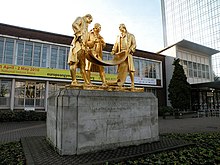
Ditherington Flax Mill in Shrewsbury was the first iron-framed building in the world in 1797. Thomas Bolton & Sons of Froghall, Staffordshire, made the world's first transatlantic telegraph cable in 1857, having supplied a submarine cable across the English Channel in 1850. On 10 July 1890, a trunk circuit telephone line was opened between London and Birmingham by the National Telephone Company; for the first time this allowed phone calls between the London and the north.[10] The world's first coaxial cable was laid between London and Birmingham in 1936 to give 40 channels for telephone traffic.[11] and brought into use in 1938, later extended to Manchester in 1940.
Much of the UK's car industry would be centred in Coventry and Birmingham; most of this has now gone.
Henry Wiggin & Co of Hereford developed the metal alloys necessary for other Midlands' (and beyond) automotive and aerospace companies – Inconel, Incoloy and Nimonic. It was the lack of vanadium for high-melting point alloys, caused by Royal Navy action, that prevented German Me 262 engines being serviceable; had German Second World War engineers had a greater supply of vanadium and molybdenum, the engine life (around 12 hours maximum, from entering service in April 1944 to the end of the war) of their jet engine would have increased much more, which would have been significant to the war's outcome. Bristol Siddeley developed the rocket engines for Black Arrow at Ansty; in fact all of R-R's rocket engines were developed and built there at R-R's Industrial and Marine Gas Turbine Division; Britain's smaller rocket engines for missiles were built by Bristol Aerojet in what is now North Somerset. High Duty Alloys at Redditch constructed (forged) the compressor and turbine blades for Whittle's first engines, and many of the early jet engines; it made Concorde's airframe from the Hiduminium R.R.58 aluminium alloy.
Maxaret, the world's first ABS braking system, was invented in Coventry by Dunlop in the early 1950s for aircraft; John Boyd Dunlop was a Scottish vet who had first produced the first pneumatic tyres in 1889. Matthew Piers Watt Boulton, grandson of Matthew Boulton, and born in the area, invented the aileron, an important flight control surface in 1868, decades before the first actual flight. Triumph Engineering was a famous motorbike firm in Meriden. About a quarter of all British WWI planes were built in Coventry. The Jensen Interceptor FF was the first production four-wheel-drive car in the world, designed by Major Tony Rolt, and built at their factory in West Bromwich.
Cadbury launched
Culture
J. R. R. Tolkien grew up in Birmingham, Kings Heath, then part of Worcestershire, and was inspired by Moseley Bog and Sarehole, and perhaps by the Perrott's Folly. Philip Larkin came from Coventry. Rowland Hill (stamps) was from Kidderminster. The writer George Eliot came from Nuneaton. Anthony E. Pratt from Birmingham invented Cluedo.
Frederick Gibberd of Coventry designed Liverpool Metropolitan Cathedral. Edward Cave from Rugby made Britain's first magazine in 1731 – The Gentleman's Magazine. Philip Astley from Newcastle-under-Lyme invented the modern day circus in 1768 – Astley's Amphitheatre.
The Castlemorton Common Festival in May 1992 near Malvern, led to the Criminal Justice and Public Order Act 1994.
The
Regional assembly
The official representative body of the region is the
Demographics
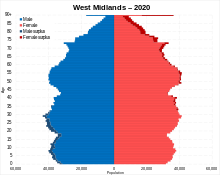
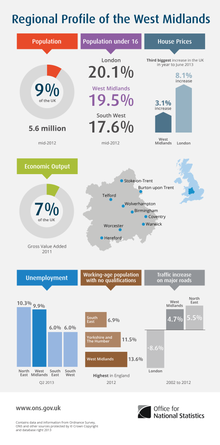
Ethnicity
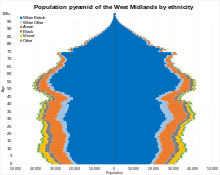

The West Midlands is the second most ethnically diverse region of the UK (London being the most diverse). This is in large part due to the West Midlands conurbation, which is highly diverse. The ethnic makeup of the West Midlands as a whole as measured by the 2011 census was as follows:
| Ethnic group | 1981 estimations[14] | 1991[15] | 2001[16] | 2011[17] | 2021[18] | |||||
|---|---|---|---|---|---|---|---|---|---|---|
| Number | % | Number | % | Number | % | Number | % | Number | % | |
| White: Total | 4,716,950 | 93.5% | 4,725,824 | 91.8% | 4,674,296 | 88.74% | 4,633,669 | 82.7% | 4,585,024 | 77% |
| White: British | – | – | – | – | 4,537,892 | 86.15% | 4,434,333 | 79.2% | 4,275,557 | 71.8% |
| White: Irish
|
– | – | – | – | 73,136 | 1.38% | 55,216 | 1.0% | 47,886 | 0.8% |
| White: Irish Traveller/Gypsy
|
– | – | – | – | – | – | 4,734 | 0.1% | 6,207 | 0.1% |
| White: Roma | – | – | – | – | – | – | – | – | 6,809 | 0.1% |
| White: Other
|
– | – | – | – | 63,268 | 1.2% | 139,386 | 2.5% | 248,565 | 4.2% |
Asian or Asian British : Total
|
– | – | 297,829 | 5.8% | 401,672 | 7.62% | 604,435 | 10.8% | 794,264 | 13.4% |
| Asian or Asian British: Indian
|
– | – | 158,731 | 3.1% | 178,691 | 3.39% | 218 439 | 3.9% | 276,030 | 4.6% |
| Asian or Asian British: Pakistani
|
– | – | 98,612 | 1.9% | 154,550 | 2.93% | 227,248 | 4.1% | 319,165 | 5.4% |
| Asian or Asian British: Bangladeshi
|
– | – | 19,415 | 0.4% | 31,401 | 0.59% | 52,477 | 0.9% | 77,518 | 1.3% |
| Asian or Asian British: Chinese | – | – | 9,588 | 0.2% | 16,099 | 0.3% | 31,274 | 0.6% | 33,301 | 0.6% |
| Asian or Asian British: Asian Other
|
– | – | 11,483 | 0.2% | 20,931 | 0.39% | 74,997 | 1.3% | 88,250 | 1.5% |
| Black or Black British: Total | – | – | 102,206 | 2% | 104,032 | 1.97% | 182,125 | 3.3% | 269,019 | 4.6% |
| Black or Black British: African
|
– | – | 5,305 | 0.1% | 11,985 | 0.22% | 64,253 | 1.2% | 146,089 | 2.5% |
| Black or Black British: Caribbean
|
– | – | 78,082 | 1.5% | 82,282 | 1.56% | 86,794 | 1.6% | 90,192 | 1.5% |
| Black or Black British: Other
|
– | – | 18,819 | 0.4% | 9,765 | 0.18% | 31,078 | 0.6% | 32,738 | 0.6% |
| Mixed: Total | – | – | – | – | 73,225 | 1.39% | 131,714 | 2.4% | 178,224 | 3.1% |
| Mixed: Caribbean
|
– | – | – | – | 39,782 | 0.75% | 68,533 | 1.2% | 81,193 | 1.4% |
| Mixed: African
|
– | – | – | – | 3,683 | – | 9,232 | 0.2% | 16,011 | 0.3% |
| Mixed: Asian
|
– | – | – | – | 18,160 | 0.34% | 32,561 | 0.6% | 46,478 | 0.8% |
| Mixed: Other Mixed
|
– | – | – | – | 11,600 | 0.22% | 21,388 | 0.4% | 34,542 | 0.6% |
| Other: Total | – | – | 24,328 | 0.47% | 14,083 | 0.26% | 49,904 | 0.9% | 124,226 | 2.1% |
| Other: Arab
|
– | – | – | – | – | – | 18,079 | 0.3% | 31,790 | 0.5% |
| Other: Any other ethnic group | – | – | 24,328 | 0.47% | 14,083 | 0.26% | 31,825 | 0.6% | 92,436 | 1.6% |
| Non-White: Total | 326,523 | 6.5% | 424,363 | 8.2% | 593,012 | 11.3% | 968,178 | 17.3% | 1,365,733 | 23% |
| Total | 5,043,473 | 100% | 5,150,187 | 100% | 5,267,308 | 100% | 5,601,847 | 100% | 5,950,757 | 100% |
Teenage pregnancy
For top-tier authorities in the West Midlands, Stoke-on-Trent has the highest
Social deprivation
The region, from studies of multiple deprivation, shows similarities with
The least deprived districts in 2007 (before Shropshire became a unitary authority in 2009) were Bromsgrove, South Staffordshire, Warwick, Wychavon, and Lichfield. At county level, the least deprived areas, in descending order, were Warwickshire, Worcestershire, Solihull, Staffordshire, and Shropshire.
In March 2011 the region had the second highest overall
Politics
Elections
In the 2015 general election, the Conservatives gained the largest share of the region by popular vote and took control of the number of seats, with 42% of the region's electorate voting Conservative, 33% Labour, 16% UKIP, 6% Liberal Democrat and 3% Green. The Conservatives gained 2 seats with virtually no swing from Labour to Conservative.[22]
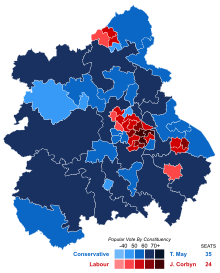
In the 2017 general election, South Staffordshire (Gavin Williamson) had the second-highest Conservative vote proportion in the UK – 69.8%. David Firth, at the University of Warwick, invented the BBC election exit poll. 6 ft 9 Daniel Kawczynski, a Shropshire MP, is the tallest MP ever.
Although having a slightly smaller percentage of the vote than the neighbouring East Midlands, the geographic area of the West Midlands is more Conservative, due to Labour's vote now consigned to the urban areas of Birmingham, Coventry and Stoke-on-Trent. The number of seats is more favoured towards Labour than the geographic spread, with 35 Conservative seats and 24 Labour. All of Warwickshire, Staffordshire, Herefordshire, Worcestershire and Shropshire is now Conservative.
Political parties
The
ITL
In the
| ITL 1 | Code | ITL 2 | Code | ITL 3 | Code |
|---|---|---|---|---|---|
| West Midlands | UKG | Herefordshire, Worcestershire and Warwickshire | UKG1 | Herefordshire | UKG11 |
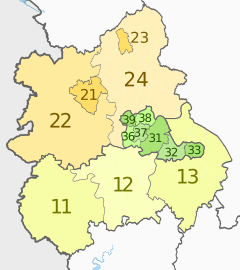
|
Worcestershire CC | UKG12 | |||
| Warwickshire CC | UKG13 | ||||
| Shropshire and Staffordshire | UKG2 | Telford and Wrekin | UKG21 | ||
| Shropshire | UKG22 | ||||
| Stoke-on-Trent | UKG23 | ||||
| Staffordshire CC | UKG24 | ||||
| West Midlands | UKG3 | Birmingham | UKG31 | ||
| Solihull | UKG32 | ||||
| Coventry | UKG33 | ||||
| Dudley | UKG36 | ||||
| Sandwell | UKG37 | ||||
| Walsall | UKG38 | ||||
| Wolverhampton | UKG39 | ||||
Local government
The region consists of the following administrative subdivisions:
| Map | Ceremonial county | Metropolitan or non-metropolitan county | Districts |
|---|---|---|---|
 |
1. Herefordshire (unitary authority area) | ||
| Shropshire | 2. Shropshire (unitary authority area) | ||
| 3. Telford and Wrekin (unitary authority area) | |||
| Staffordshire | 4. Staffordshire † | a) Stafford, g) Staffordshire Moorlands, h) Tamworth
| |
| 5. Stoke-on-Trent (unitary authority area) | |||
| 6. Warwickshire † | a) Warwick
| ||
| 7. West Midlands * | a) Walsall, g) Wolverhampton
| ||
| 8. Worcestershire † | a) Wyre Forest
| ||
Key: †two-tier non-metropolitan county | *metropolitan county including the West Midlands Combined Authority and mayor
Demography
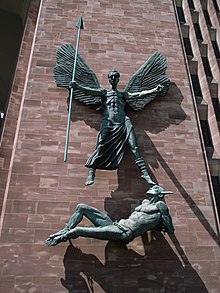
| Ceremonial County | Population | Population density | Largest local authority | Largest settlement |
|---|---|---|---|---|
| West Midlands (region) | 5,267,337 | 405/km2 | Birmingham (1,006,500) | Birmingham (1,006,500) |
| West Midlands (county) | 2,600,100 | 2,884/km2 | Birmingham (1,006,500) | Birmingham (1,006,500) |
| Staffordshire | 1,062,500 | 391/km2 | Stoke-on-Trent (240,636) | Stoke-on-Trent (259,252) |
| Worcestershire | 552,900 | 318/km2 | Wychavon (116,300) | Worcester (93,400) |
| Warwickshire | 522,200 | 264/km2 | Warwick (132,900)
|
Nuneaton (70,721) |
| Shropshire | 451,100 | 129/km2 | Shropshire (290,900) | Telford (138,241) |
| Herefordshire | 177,800 | 82/km2 | N/A[26] | Hereford (50,400) |
The West Midlands' population accounts for almost 11% of England's overall population. 49.36% of the region's population resides in the West Midlands county, 20.17% in Staffordshire, 10.49% in Worcestershire, 9.91% in Warwickshire, 8.56% in Shropshire, and 3.37% in Herefordshire.
Economy
Highways England. NHS West Midlands, the strategic health authority was in Edgbaston. The West Midlands Ambulance Service is in Brierley Hill, near the headquarters of West Midlands Police, where the Child Support Agency (CSA) was headquartered. The region's Manufacturing Advisory Service was on Wolverhampton Science Park, north of the city centre; this function is now represented by Made in the Midlands, north of Wolverhampton.[28]
The Warwickshire & Northamptonshire Air Ambulance, based at Coventry Airport; both are charity-funded. Sir Anthony Bamford of Staffordshire is the richest British industrialist, at around £3.15bn in 2014; Sir James Dyson is second (£3bn).
Education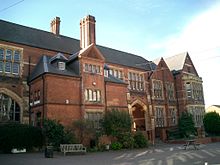 Secondary educationSelective schools are in low numbers as follows: Birmingham (8), Walsall (2), Wolverhampton (1), Warwickshire (6), Stoke-on-Trent (1), and Telford and Wrekin (2). The highest proportion per head therefore is Warwickshire (its population is between 550,000 and 600,000 people). The other counties and metropolitan boroughs have none, their public education systems are comprehensive in intake. The grammar and independent schools tend to produce pass-rate examination results among the top twenty ranked regionally. Many pupils compete for entrance examinations to attend such long-established Grammar Schools and most have significant parent sponsorship. In 2016 two of the top ten such schools nationally were in Warwickshire, where in the CV37 postal district prices were 34% higher than the county as a whole.[30]
Around 275,000 secondary schools are in the region, the greatest number after the South East, Greater London and North West. At GCSE based on % of entrants' pass rates, the best performing local government area in 2010 was Solihull, closely followed by Warwickshire and Shropshire. Dudley, Herefordshire, Telford and Wrekin, Birmingham and Staffordshire (in descending order) are above the English average, at which rate, is approximately Worcestershire. The area consistently having fewest passes is Sandwell, followed by Stoke-on-Trent. Struggling pupils in Wolverhampton and Walsall also attain fewer passes than the English average in most GCSE years, sometimes by a very narrow margin. For metropolitan boroughs, Solihull then Dudley perform best. Dudley is the best metropolitan borough at A-level passes and has a consistent post-2000 history of being better than Solihull.[citation needed] According to The Guardian, schools have been off-rolling pupils.[31] Pupils likely to perform poorly in examinations are expelled before the examinations to improve the school performance in league tables. Expelled pupils then disproportionately get involved in gangs and in crime. Knife crime in the West Midlands is the highest outside London.[32] In 2010, regionally in persistent Bromsgrove had the lowest at 2.3%.[33][needs update ]
Tertiary educationThere are thirty-seven FE colleges (FECs). School children in Shropshire and Solihull are most likely to attend university, followed by Herefordshire, Worcestershire and Warwickshire. School league tablesBelow is a list of the top twenty state schools in the West Midlands by 2010 A level results:[needs update]
Universities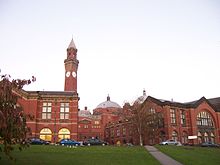 
The University of Birmingham is the main university in the region Around 45% of students are from the region, and 35% from other parts of the UK, while 20% are from overseas. The region attracts students from South East England owing to good access via the M40 and the West Coast Main Line, but there is a good mix from other regions too, except the North East (especially) and Yorkshire. Students native to the West Midlands are most likely to study in the region (40%), then the East Midlands (12%), the North West (11%), and then Yorkshire (9%). Very few go to the East of England or the North East. The region has a net export of university students to other regions. At time of graduation in 2010 almost 60% of graduates remained in the West Midlands, with 10% going to London, 7% to the South-East, and around 5% to the East Midlands. Very few go to Yorkshire, the North-East, or even (neighbouring) Wales. TransportRailwaysServed by many lines in the urban areas such as the Chiltern Line. There are plans[when?] to reopen the Gloucestershire Warwickshire Railway. [citation needed] The HS2 (High Speed Two) project is planned to connect London to Birmingham by 2026.
Road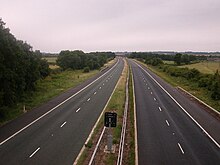 Several notable roads pass through the region, with most converging around the central conurbation. The M6 toll provides an alternative route to the M6 between Coleshill and Cannock, passing north of Sutton Coldfield and just south of Lichfield .
The M40 connects the region through South East England to London, with its northern terminus at its junction with the M42; it passes close to Warwick and Banbury. The M42 connects the M5 at Bromsgrove, passing around the south and east of Birmingham, joining the M40 and M6, passing Solihull and Castle Bromwich, to Tamworth, northeast of Birmingham. The M50 connects the M5 from near Tewkesbury to Ross-on-Wye in the southwest. The M54 connects Wellington in the west, passing Telford, to the M6 near Cannock. The A5 road traverses the region northwest–southeast, passing through Shrewsbury, Telford, Cannock, Tamworth and Nuneaton. The longest elevated road viaduct in the UK is the 3 miles (4,779 m) section from Gravelly Hill to Castle Bromwich on the M6, opened on 24 May 1972; the 3.5 miles (5.6 km) Bromford Viaduct is the longest viaduct in the UK. The section of the A45 in Coventry from Willenhall to Allesley in 1939 was one of the UK's first ever large planned road schemes; road schemes on that scale had not been previously built, with few large road schemes outside of London, or were piecemeal. Princes Square in Wolverhampton had Britain's first automatic traffic lights on 5 November 1927. Transport policyAs part of the transport planning system, the Regional Assembly is under statutory requirement to produce a Highways England and Network Rail.[39]
Within the region, the local transport authorities carry out transport planning through the use of a local transport plan (LTP) which outlines their strategies, policies and implementation programme.[40] The most recent LTP is that for the period 2006–11. In the West Midlands region, the following transport authorities have published their LTP online: Herefordshire,[41] Shropshire U.A.,[42] Staffordshire,[43] Telford and Wrekin U.A.,[44] Warwickshire,[45] West Midlands[46] and Worcestershire.[47] The transport authority of Stoke-on-Trent U.A. publishes a joint local transport plan in partnership with Staffordshire County Council to cover the North Staffordshire Major Urban Area, which includes Stoke-on-Trent and the more urban parts of Newcastle-under-Lyme and Staffordshire Moorlands.[48] MediaTelevision The West Midlands region of the ITV Central broadcasts from Birmingham, off Broad Street on Gas Street next to the Worcester and Birmingham Canal, with its ITV News Central regional programme.
Some northern parts of the region, including Biddulph, receive BBC North West Tonight and Granada Reports both of which are based at MediaCityUK in Salford and are broadcast from the Winter Hill transmitter. The BBC has its engineering training centre at Wood Norton, Worcestershire, off the A44 north of Evesham in Norton and Lenchwick. BBC English Regions is based at Birmingham.
RadioBBC LocalThe West Midlands is served by numerous BBC Local Radio stations, including BBC Radio WM, BBC CWR, BBC Radio Stoke, BBC Hereford & Worcester, BBC Radio Shropshire and BBC Radio Derby (covering East Staffordshire). CommercialCommercial radio stations include Sunshine 855 and Sunshine Radio Herefordshire & Monmouthshire .
CommunityCommunity radio stations include:
Stafford is also notable for .NewspapersLocal newspapers include:
MagazinesWilliam Gibbons of Wolverhampton prints ] The Polestar Varnicoat works on the A44 in Pinvin, north of Pershore, for many years[when?] printed Woman's Own, Heat, Pick Me Up, Chat, and That's Life. OnlineChannel 4's 4Talent network has a hub in the West Midlands dealing with rising media talent from the region.[50] Sport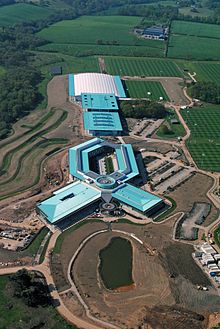 The National Sports Centre at Lilleshall Hall is in Sheriffhales, Shropshire, north-east of Telford; it was largely established by the Central Council of Physical Recreation in 1949 as a National Recreation Centre; the south of England had theirs at Bisham Abbey on the Thames. St George's Park National Football Centre is at Tatenhill near Byrkley Park in Needwood Forest, near former the RAF Tatenhill off the A515, four miles west of Burton upon Trent. The Tough Guy Competition, now a widespread sport competition in the US, began in 1987 on a farm at Perton in Staffordshire. The main British athletics championships are held in Birmingham in late June. The Olympic Movement started at Much Wenlock, and also to the east of region, where Baron de Coubertin formulated his ideas for sport and the Olympics at Rugby School in 1883, with the headmaster Thomas Arnold, whose son would be the famous poet Matthew Arnold and whose great-grandson would be Aldous Huxley. FootballRugbyIn Premiership teams Wasps RFC and Worcester Warriors. In rugby league, Midlands Hurricanes play in the third tier League 1 .
TennisBritain's first tennis club was founded in 1872 in Leamington Spa. The modern rules of lawn tennis were developed in 1874 by Leamington Tennis Club. Tennis was pioneered in Edgbaston in 1859, and Edgbaston Archery and Lawn Tennis Society also claims to be the oldest tennis club in the world, where tennis was invented by Major Harry Gem and the Spaniard Augurio Perera.[citation needed ]
Motor sportTeam Dynamics at Pershore, has won the British Touring Car Championship. References
Further reading
External links
|

